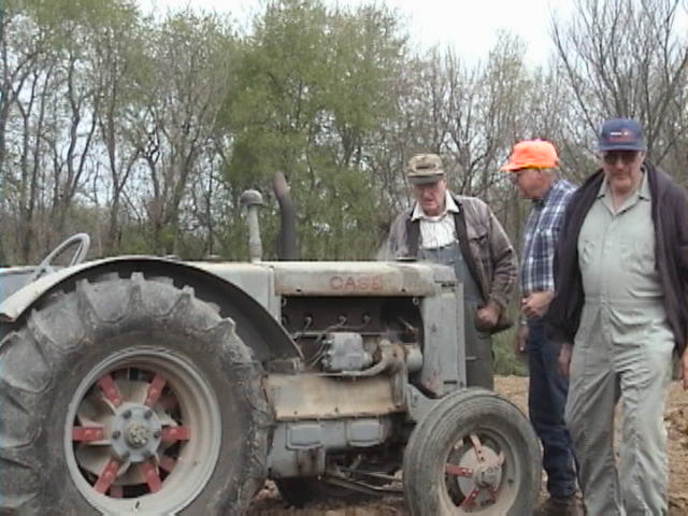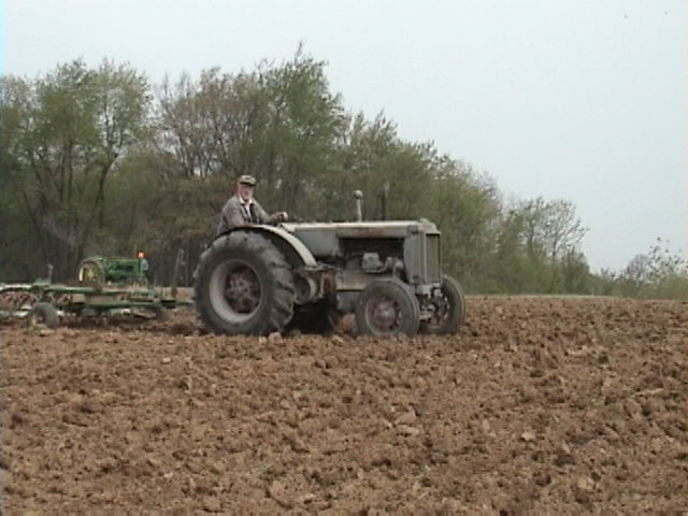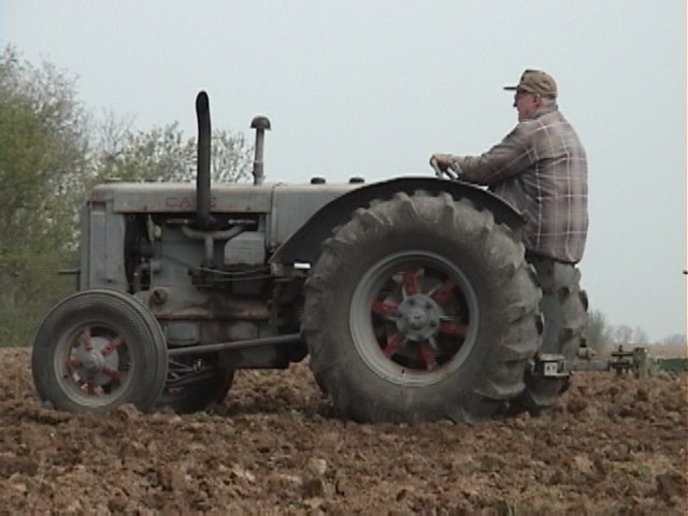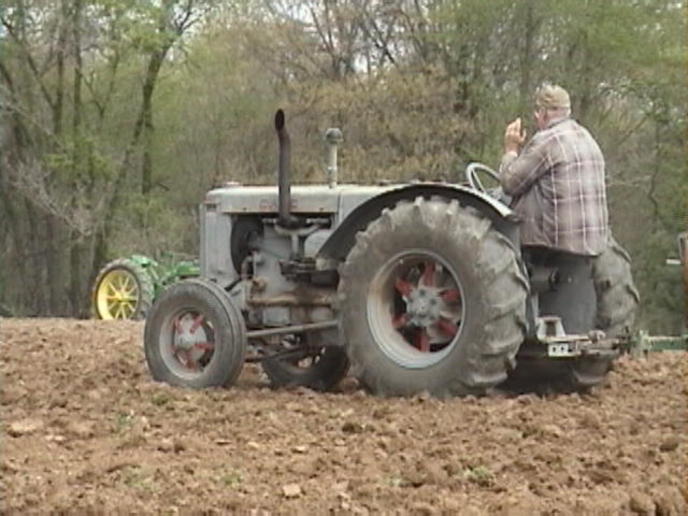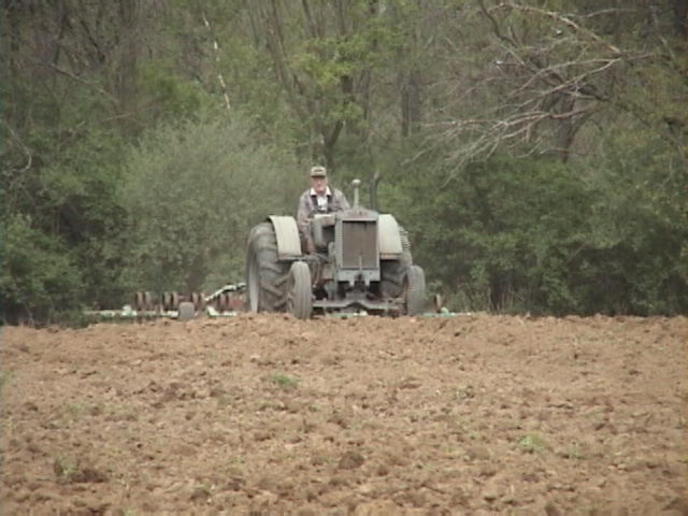If you are in the deep freeze (-15) like I am, here is a tractor story to read if you want to.
This was my dad’s tractor and it now resided in my barn, in running condition, in central Illinois. It is a family heirloom. I was born in early 39 and this tractor was built only few months earlier in 38. That makes us both 75 years old. That’s me in the blue cap my older brother in the gray cap and my younger brother in the red cap.
I first saw this tractor at about age 11 parked at a machinery lot in Eskridge, Kansas. I suppose it got my attention because it was parked close to the road and it looked a little weird to me. It was configured like the later DC4. It had big diameter steel wheels behind and rubber tires in front but It looked very nose down as if the front wheels were in a ditch.
I never gave this Case a second thought because my older brother and I both wanted dad to get rid of his worn out Rumley DoAll and buy an “affordable” John Deere GP. We were financially poor farmers so a late model tractor was definitely out of the question. Dad farmed with junk but he was a skilled blacksmith and he could fix up junk.
I had seen various John Deere GPs setting out back on junk row at John Deere dealers. To my surprise one day, dad told my older brother and me that he had bought a tractor and we were going to go drive it home. As I recall, dad would not tell us what he bought so we rode the 12 mile to Eskridge in suspense. A John Deere dealer was in Eskridge and I wanted a GP. Hope! Hope! I was disappointed when dad drove on by the John Deere dealer about half a mile and stopped near this weird, 11 year old Case tractor and proceeded to tell us that he had bought it. <sigh>
This old Case tractor still looked weird but in a different way than when I had first seen it a few weeks earlier. Days before we arrived to drive it home, dad had made a deal with the dealer to cut the tall steel wheels off and weld on small 10-24 inch rims that were the correct size for a pair of almost bald rear tires that dad could afford. Now, this still weird looking tractor sat level but the fenders were way too big for the small tires. Later, dad lowered the fenders as they are seen in the pictures.
We always called it a C Case---because it looked more like a C than a CC. The serial tag says it’s a CC. It might have originally had the narrow goose neck up front. Maybe some forerunners of the DC4 were also tagged CC. I don’t know. I have always been curious about its original configuration. The front axle spindles are in their low axle position. This suggests the front axle was taken from a model C and put on the CC.
Can anyone trace a serial number as to how the factory may have configured my dad’s tractor? Was there an un-styled C series forerunner to the DC4? If so, how was it labeled on the serial plate? A neighbor had a C series (un-styled) with large diameter rears with its front axle spindles in the high axle position. It went fast on the road as if it had a 4th gear. Was there every an un-styled C series with a 4th gear?
My older brother was about 15 at the time and dad allowed him to run it in the field. He soon recognized the good features of this old Case tractor. For a year or more, I stewed over the fact that it’s not a John Deere. However, I could not overlook how much power it had. It had about twice as much as the old DoAll. I could not overlook the fact that when belted to the feed grinder, the belt did not go flippidy-flop as John Deere’s in the neighborhood were known to cause the belt to do.
It would ALWAYS start on the 3rd or 4th pull of the crank on the coldest days. Dad later added an un-styled B John Deere to the farm for light work but it would hardly start in cold weather. The oil clutch with hand lever on the C was a dream. One could stand on the ground and inch the tractor forward or back to hook it up. My uncle’s Regular and F20 Farmalls were beasts to hook up and drive but dad’s C was not that way.
The feed grinder was an easy belt chore but my Uncle’s large, stationary silage cutter needed a big horse on the belt. The C was up to the task. One day while chopping silage, a young man and dad were pitching corn bundles into the silage cutter. The young man said to dad—“bet I can kill that old Case”. The young man started pitching bundles like a mad man to the point where the upper feed roller was topped out and squeezing bundles hard. I watched. The old C just barked a little louder and dropped maybe a 100 rpm. The young man gave up in what seemed about 2 minutes. I knew the old Case could spin its bald tire in third gear but the silage cutter was the real deal. This was the WOW moment for me.
Early on after we had the C for a while, another WOW moment for the Case brand was when the sound of an unusual engine was coming up the road behind the tree line. When in sight, I could see it was an LA!!! A neighbor had a son living 300 miles away in big wheat country. The son’s LA had been imported to our little community to do some heavy tillage for his dad. Our community had nothing bigger than M Farmalls and one G John Deere. I had never been around an LA. Its size and power and watching it work was another WOW moment.
I became hooked on the Case brand. During the years we used the C, I dreamed of having a DC but that was not to be until about 30 years later when I started restoring several of the D series. After about 10 years of using the old C Case, I left dad’s farm and pursued an Engineering career 400 miles away. The old C stayed on dad’s farm for 35+ years as other used tractors came and went. Many more stories could be told about the old Case. It plowed under my billfold and drivers license one day. etc. etc.
About 20 years ago, I hauled the old C Case from Kansas to my central Illinois farm. Later, dad’s 2 bottom plow that we pulled with the old Case plowing mostly tough gumbo also got hauled to my farm. Here, the old Case got new tires and paint that dried too light shade of gray. I told myself the second coat will be right but so far that has not happened. It pulls dad’s plow once in a while and has run my grain auger, etc.
The pictures were extracted from video of when my two brothers came to Illinois to play with old tractors. Several times over the years, we have plowed a 90 acre field of wheat stubble with our 10 antique tractors and my plow collection.
I don’t think the old C Case has ever been rained on since arriving in Illinois. It has priority for a parking place in my barn. Dad never had a machine shed so it sat out in the weather the first 25+ years that he had it. Dad was fussy about covering exhaust pipes so the engine’s internals stayed in good condition. Dad also made a side panel to keep the mag dry. It does not smoke and runs good. It got new Aluminum pistons and sleeves one time in the late 50s. Its paint disappeared and it became rusty.
After about 25 years, it was no longer being used as dad was no longer farming. During one of my many trips back to Kansas dad’s cattle shed now had some free space. I backed the old Case into the NE corner of the cattle shed and it sat under roof for about ten years before I hauled it to Illinois. A few of the neighbor’s cows also occupied the cattle shed and they “decorated” the old Case in the cattle shed.
A current dilemma is what will become of dad’s old C Case? My children, grandchildren, and nephew have other interest. Dad’s old Case and plow have a good story line and thus would make a good museum pair where actual history and storylines are described. Many museums want “original” and I understand that. <sigh>
